- Cisco is refocusing to compete in a cloud-driven world
- The company’s growth aspirations depend on a service-based model
- The Wall Street consensus outlook is bullish
- The market-implied outlook is bullish
- CSCO needs to deliver higher growth than in recent years
Networking giant Cisco (NASDAQ:CSCO) has adapted somewhat slowly to the huge shift in IT spending, which now favors cloud-based solutions. Going forward, the company is emphasizing software subscriptions, cloud solutions and work-from-anywhere as its focus for growth.
While management is saying all the right things, CSCO’s earnings and revenue growth in recent years is disappointing. The consensus for expected earnings growth indicates a prevailing belief that the San Jose, California-based firm's turnaround efforts will not be very successful. The consensus for 3-5 year EPS growth is 5.9% per year, far below the 15.5% median expected growth rate for the IT sector.
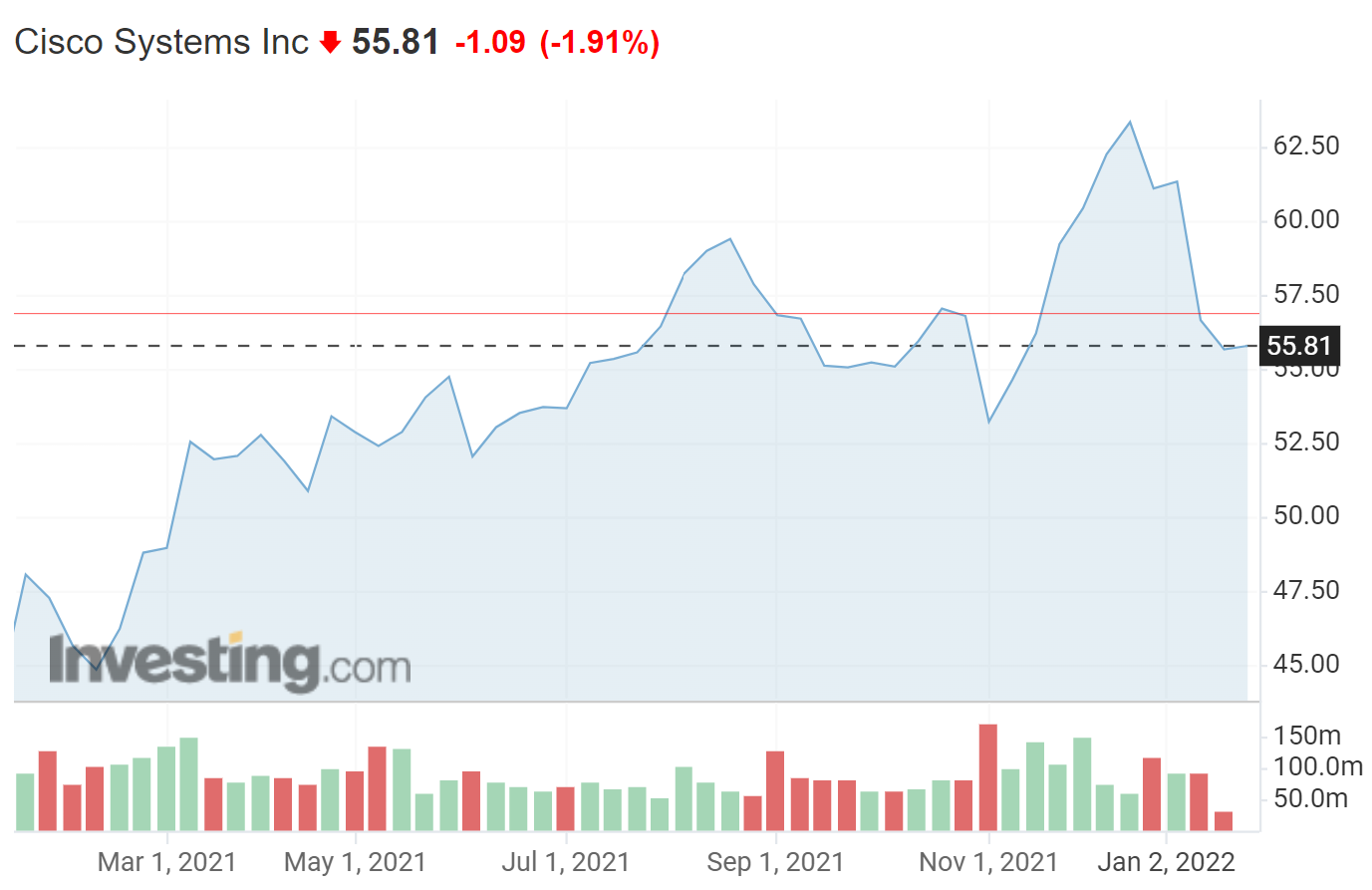 Source: Investing.com
Source: Investing.com
CSCO has fallen 12.4% from its TTM high close of $63.96 on Dec. 29 but its 12-month total return of 30.4% is far above that of the NASDAQ 100. The TTM total return for Invesco QQQ Trust (NASDAQ:QQQ) is 9.1%.
Over the longer term, CSCO’s performance lags, with a three-year annualized total return that is about half that of the S&P 500 and the current share price is below levels the stock reached in July of 2019.
The quarterly EPS has been flat over the past three years, and the expectations over the next year and beyond are for more of the same. Even though the TTM P/E of 21.2 for CSCO is low for a big tech firm, the lack of earnings growth over the past three years is definitely a concern. Source: E-Trade. Green values are the amounts by which earnings exceeded the consensus expected level.
Source: E-Trade. Green values are the amounts by which earnings exceeded the consensus expected level.
I last wrote about CSCO on Oct. 21 and assigned a bullish/buy rating. The key drivers of the rating were:
- low valuation for a big tech firm,
- bullish Wall Street consensus outlook and
- bullish consensus outlook from the options market.
While most readers will be familiar with (1) and (2), the use of options to form an outlook may be new.
The price of an option on a stock reflects the market’s consensus estimate of the probability that the share price will rise above (call option) or fall below (put option) a specific level (the option strike price) between now and when the option expires. By analyzing the prices of call and put options at a range of strikes, all with the same expiration date, it is possible to calculate a probable price forecast that reconciles the observed options prices. This is called the market-implied outlook and reflects the consensus view of buyers and sellers of options.
Since my last analysis was published, CSCO has had a total return of +1.58%, as compared with -3.3% for the S&P 500 over the same period.
I have updated the market-implied outlook for CSCO to the middle of 2022 and to the start of 2023 and compared it with the Wall Street consensus outlook.
Wall Street Consensus Outlook For CSCO
E-Trade calculates the Wall Street consensus outlook by combining the views of 18 ranked analysts who have published ratings and price targets for CSCO over the past 90 days. The consensus rating is bullish, as it has been for the past year, and the consensus 12-month price target is 17.5% above the current share price. The consensus 12-month price target is slightly higher than it was three months ago ($63.78). Of the 18 analysts, nine assign a buy rating and nine assign a hold.
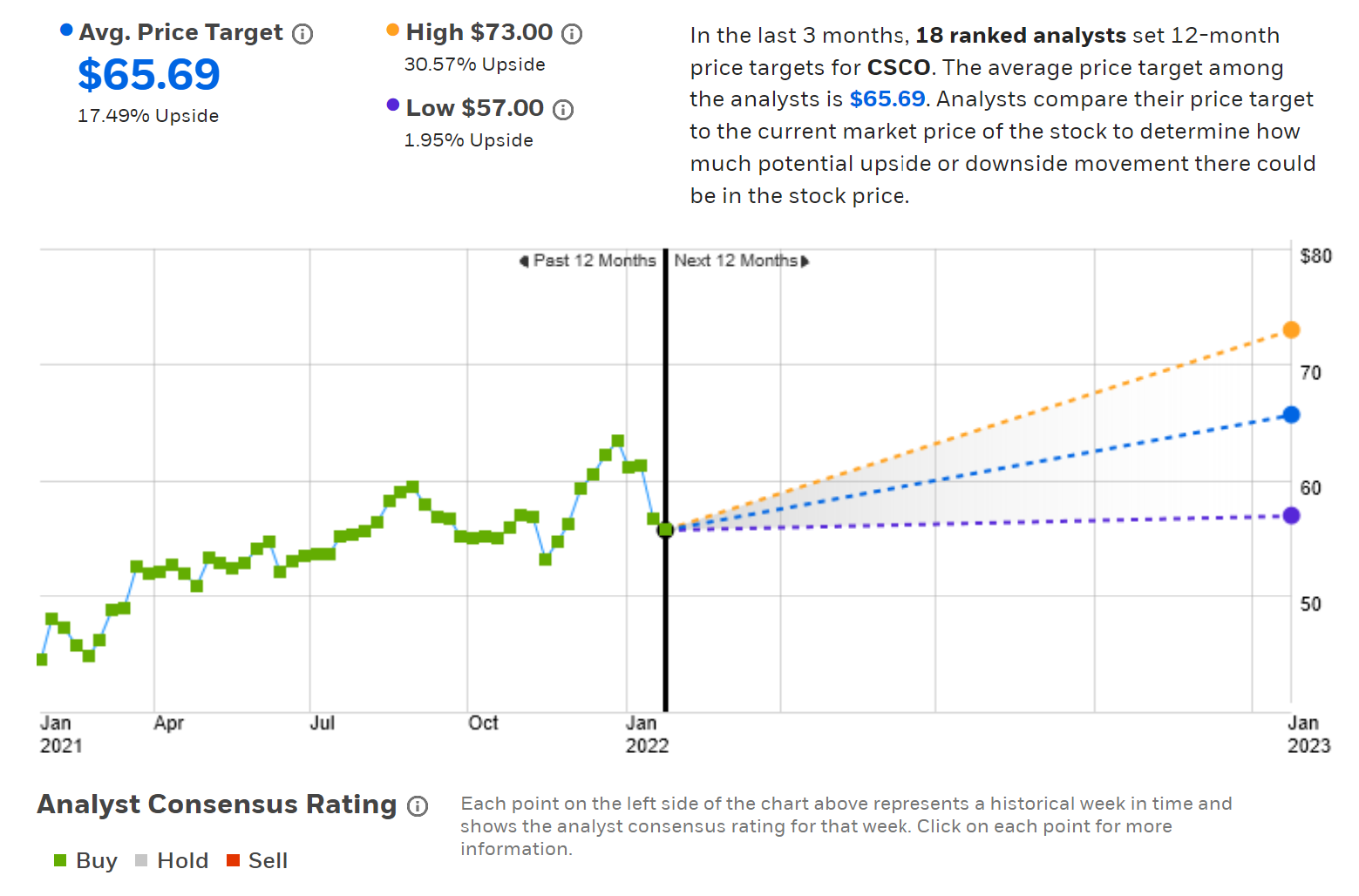 Source: E-Trade
Source: E-Trade
Investing.com’s version of the Wall Street consensus is calculated by aggregating the views of 29 analysts. The consensus rating is bullish and the consensus price target is 9.35% above the current price. The consensus price target is markedly lower than for E-Trade because of an outlier analyst with a $30 price target for the stock. Consistent with E-Trade’s results, the analyst ratings are almost evenly split between buy and hold.
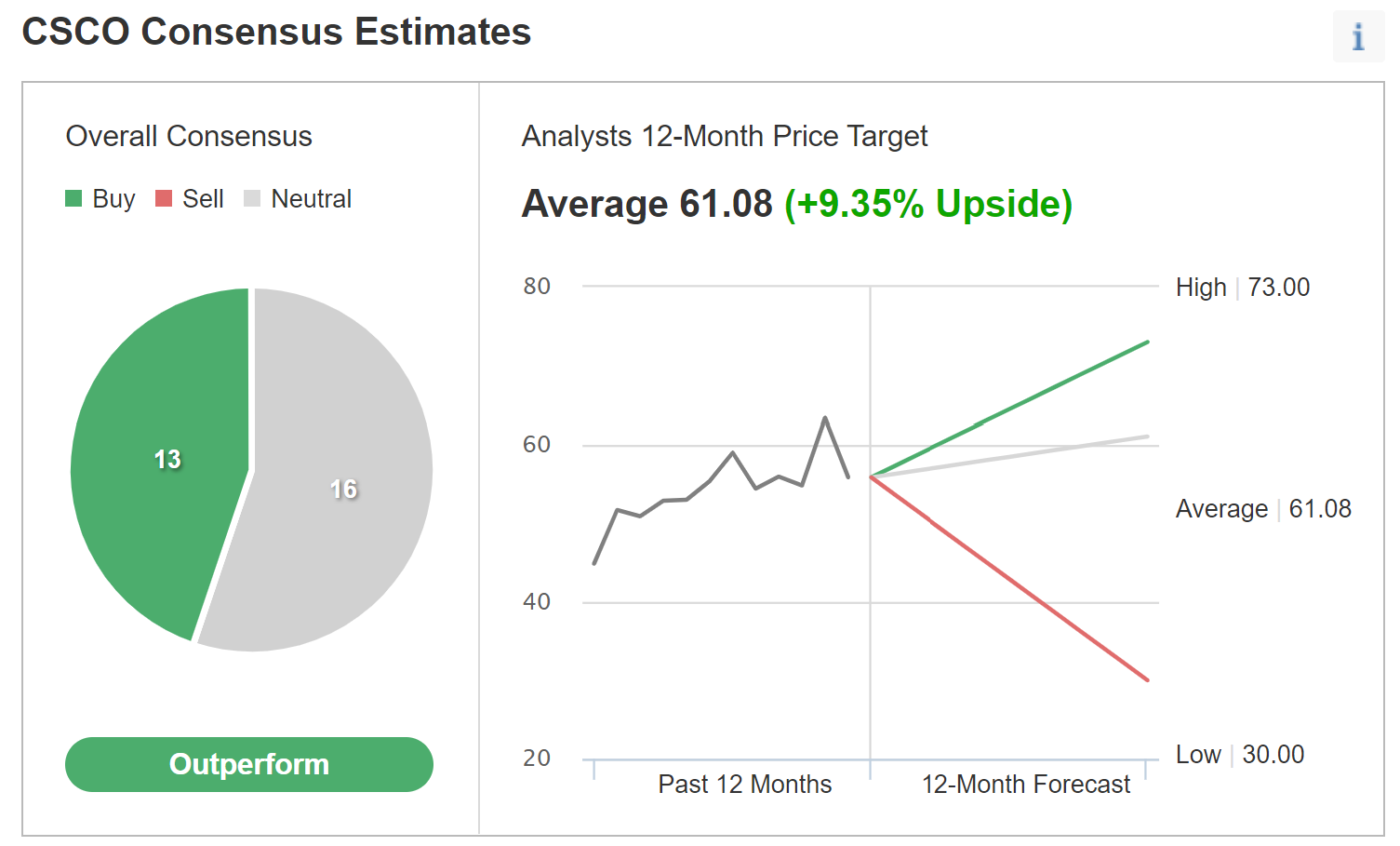 Source: Investing.com
Source: Investing.com
The difference between the 12-month consensus price targets from these two sources has a major impact on the expected price appreciation. To attempt to reconcile the spread, I looked at Seeking Alpha’s calculation for the consensus price target. At $63.5, Seeking Alpha falls between the 12-month consensus price targets from E-Trade and Investing.com.
The average of the Investing.com and E-Trade’s 12-month consensus price targets, $63.39, implies 12-month price appreciation of 13.4%. Combined with the 2.6% dividend yield, the expected total return is 16%, close to the trailing five-year annualized return of 15.7% and well above three-year annualized return of 10.3%.
Market-Implied Outlooks For CSCO
I have calculated the market-implied outlook to mid-2022 (using options that expire on June 17, 2022) and through 2022 (using options that expire on Jan. 20, 2023).
The standard presentation of the market-implied outlook is in the form of a probability distribution of price return, with probability on the vertical axis and return on the horizontal.
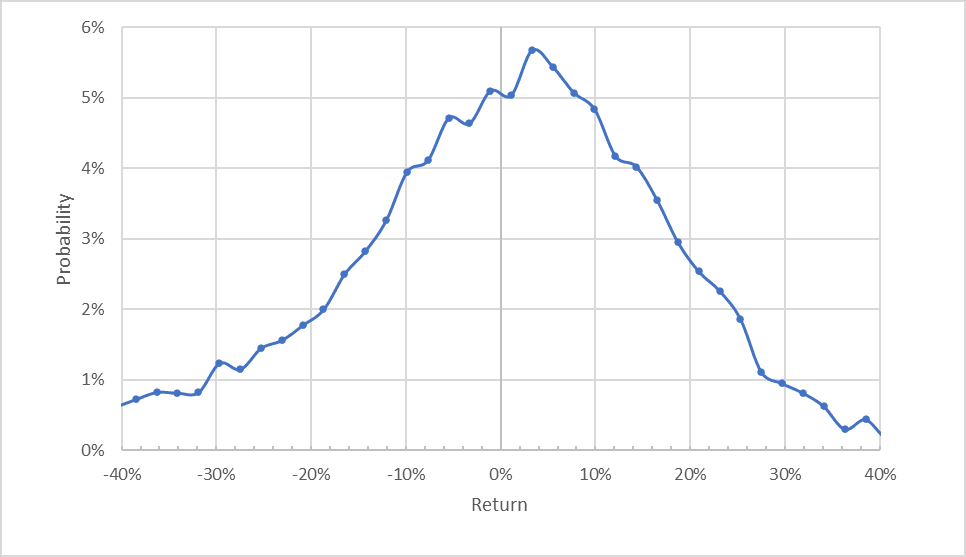
Source: Author’s calculations using options quotes from E-Trade
While the market-implied outlook is generally symmetric, the peak probabilities are shifted towards positive returns, a bullish indicator. The maximum-probability outcome corresponds to a price return of +3.4%. The annualized volatility calculated from this distribution is 32.2%.
To make it easier to directly compare the probabilities of positive and negative returns, I rotate the negative return side of the distribution about the vertical axis (see chart below).
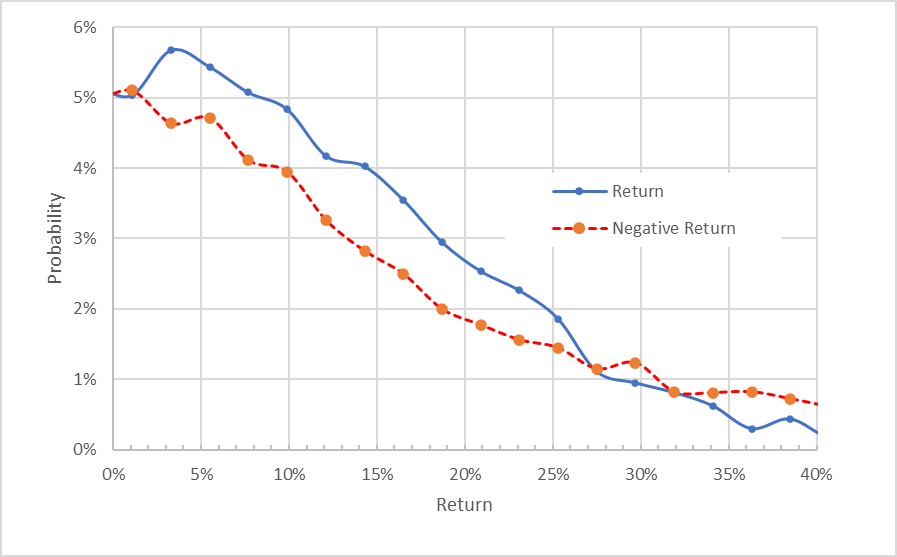
Source: Author’s calculations using options quotes from E-Trade. The negative return side of the distribution has been rotated about the vertical axis.
This view makes the bullish tilt of the market-implied outlook very evident. The probabilities of positive returns are markedly and consistently higher than for negative returns of the same magnitude for a wide range of the most-probable outcomes (the solid blue line is well above the dashed red line over the left ⅔ of the chart). This is a bullish outlook for CSCO to the middle of 2022.
Theory suggests that the market-implied outlook will tend to have a negative bias, reinforcing the bullish view to mid-2022.
The market-implied outlook for the next 11.8 months is less bullish, with closely matching probabilities of positive and negative returns. The probabilities of negative outcomes tend to be very slightly above those for positive outcomes. Because of the expected negative bias, this is still interpreted as a neutral outlook with a slightly bullish tilt. The annualized volatility calculated from this distribution is 31.3%.
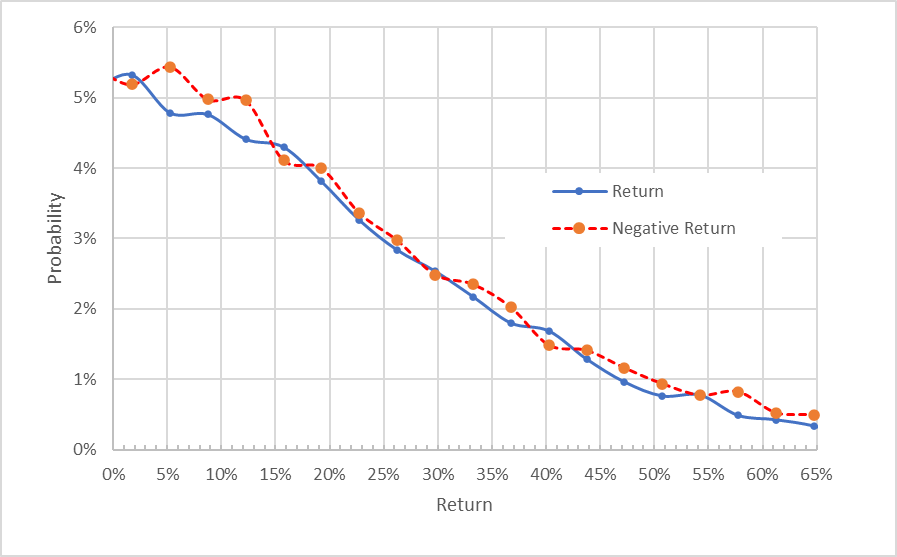
Source: Author’s calculations using options quotes from E-Trade. The negative return side of the distribution has been rotated about the vertical axis.
The market-implied outlooks are bullish to the middle of 2022 and neutral with a slight bullish tilt for the full year. The expected volatility is stable at about 31.7%.
Summary
While CSCO’s valuation is quite modest for a big tech firm, the company’s revenue and earnings growth in recent years is sub-par.
Cisco is trying to catch up with the market shift towards the cloud and everything-as-a-service. The consensus outlook is that growth will continue to lag, but the valuation provides some potential for price appreciation.
The Wall Street consensus outlook for CSCO is bullish, with expected 12-month total return of about 16%. As a rule of thumb for a buy rating, I want to see an expected 12-month return that is at least half the expected volatility, and CSCO just meets this criterion using the Wall Street consensus price target and the expected volatility from the market-implied outlook.
The market-implied outlook for CSCO is bullish to the middle of 2022 but neutral, albeit with a slight bullish tilt, for the full year. I am maintaining my overall buy rating for CSCO, but plan to re-evaluate after the middle of the year.
